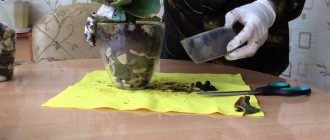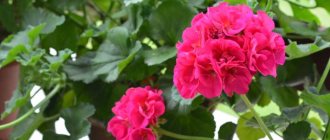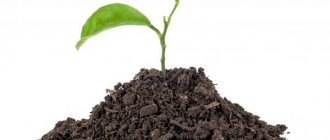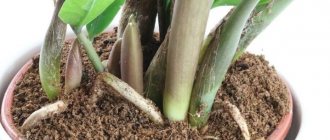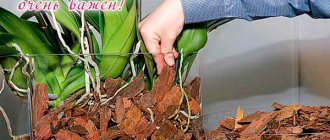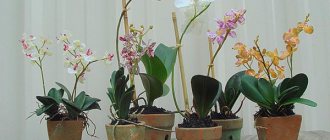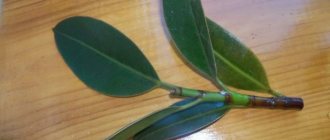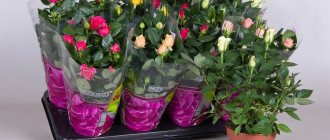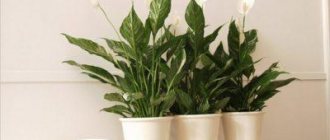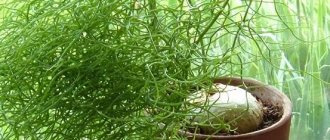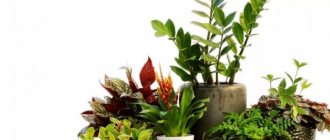Basic rules for planting house plants
Indoor plants are divided into 4 large groups and numerous types, each of which requires certain conditions of maintenance and care (temperature, humidity and lighting, watering regime, soil and pot size, frequency of fertilization, and so on).
But, despite such a variety of plants, it is quite possible to identify basic rules for the care and maintenance of house flowers that apply to all or at least most species and groups. This applies to the choice of soil, pots, drainage and the actual process of planting/transplanting/transferring flowers. We will look at how to plant a home flower correctly in this article.
Features and rules for planting indoor plants
Proper planting of indoor flowers can provide them with the best possible start for further growth, development, flowering and even fruiting. It includes:
- Selecting store-bought soil with a suitable composition or making your own soil mixture from individual components.
- Selection of the volume of the pot corresponding to the size and degree of development of the root system of the flower, taking into account its future parameters and requirements for active growth.
- Selection of drainage material, which must be placed at the bottom of the pot before planting the plant.
- Compliance with the correct technology for planting, replanting or transshipment of plants at home.
Let us now consider each of the above points in a little more detail.
Why rooting may not occur
Fuchsia in a pot outside - how to care for it and what pot to plant it in
It is quite easy to recognize by appearance whether rooting has occurred. The stem should not be dried out or blackened; new shoots should appear on it. If after 3-4 weeks the leaves on the cuttings begin to curl or dry out, this means that rooting has not occurred. The reasons for this may be different:
- incorrect distribution of nutrients for root formation, which occurs if the cutting has sprouted many new buds and leaves. In order for roots to grow, the leaves must be trimmed;
- excessive watering or lack of drainage can lead to rotting of the cuttings;
- room temperature is too low. For rooting it should be within +20-24;
- the development of harmful microorganisms and rotting of the crop due to failure to pre-disinfect the planting container;
- too small a container for planting can lead to the death of the cutting;
- the absence of sand and humus makes the soil too dense and limits its breathability;
- lack of ventilation will cause the cutting to “suffocate” under the plastic container.
To learn how to make a shoot from a rose and plant it at home, you need to understand some of the nuances. This is done by rooting cuttings and is possible subject to certain conditions. Before you begin propagation, you need to carefully select the stem for cuttings - powerful, bright green with developing buds.
Soil selection
Each potted crop may require its own soil composition, so the soil for planting flowers should be selected depending on the plant being transplanted. Flower shops sell either specialized soils (for ficus, palm trees, violets, cacti, begonias, etc.) or universal ones (for decorative deciduous, decorative flowering, cacti and succulents, etc.).
Knowing the growth characteristics and soil preferences of a flower, you can not only choose the right ready-made soil, but also improve the quality of the universal one - add various cultivators (peat, coconut, perlite, vermiculite) and vermiculite to the composition.
Choosing a pot/plant pot
Flower shops today offer a huge variety of pots and flowerpots. What is the difference between a pot and a flowerpot? The flower pot has one or more drainage holes on the bottom, which are designed to drain excess water when watering the plant.
The pots do not have holes at the bottom and are used not for planting flowers, but for interior decoration. It can be completely carved, woven from wicker, carved from stone, made from wood, metal, plastic, glass, etc.
Also, a flower pot of a certain shape can be hung on the wall, and if there are special holes/hooks/ears, it can be hung with a cord from the ceiling (window, terrace beam, etc.) and a pot with a beautiful flowering hanging plant can be placed in it.
The range of flower pots is no less wide and numerous. It includes products from:
- Clays. The finished product can be fired, painted, glazed, or without any decoration on the outer surface. Clay pots are usually made of a standard shape and proportion, where the ratio of height to diameter is 3:1. A simple clay pot is the most environmentally friendly, has a porous structure and allows air to pass well to the root system. Among the disadvantages, we can note the very rapid drying out of the earthen ball in hot conditions, as well as the rapid loss of appearance of the clay pot (the appearance of streaks and stains, the absorption and deposition of salts).
- Ceramics. The main advantage of ceramic pots is beauty and grace. Despite the fact that they are made from natural material, the glazed coating inside and outside prevents the roots of the flower from breathing and the walls from evaporating excess moisture when watering. In addition, the glaze releases components harmful to flower growth into the soil, and the pots themselves are quite expensive, heavy and fragile to use.
- Plastics . Plastic products are easy to use and care for. Plastic walls do not allow air to reach the roots, but this disadvantage is more than compensated for by the presence of numerous drainage holes. An earthen ball entwined with roots can be easily removed from a plastic container to transplant the plant; to do this, you just need to knead the walls of the pot with your hands. A palette of colors from standard black to bright and multi-colored can decorate any window sill with flowers.
- Glass/plexiglass. Glass and transparent plexiglass pots are used by indoor floriculture enthusiasts mainly for growing orchids. They transmit the sunlight necessary for orchid roots, and also allow you to visually monitor the condition of the substrate and root system of the flower. The pots are environmentally friendly, relatively durable, and do not react to fertilizers. The downside may be the lack of drainage holes, the need for exclusively top watering and the possibility of flooding the plant if excess water is not removed from the substrate.
- Metal . Metal pots heat up quickly and cool just as quickly, which can lead to overheating or hypothermia of the root system. They are best used as original flowerpots for high-tech interiors.
- Tree. Wooden pots are environmentally friendly and aesthetically pleasing; they can be of any shape - from polygonal to spherical. It is best to use large floor pots made of wood for planting large decorative foliage plants.
- Stone. In a pot made of natural stone, the plant will be uncomfortable - the stone will either overheat or cool the roots of the flower too much. The stone can be used as a decorative element (stand/vase/plant pot) or in the form of large flowerpots for planting large plants.
- Pressed peat . Peat pots are indispensable when planting seeds of plants with a fragile and vulnerable root system. The young sprout can be planted in another container without removing it from the peat pot. This minimizes the risk of damage to fragile roots.
What is drainage and why is it needed?
Drainage is an inert material that is placed at the bottom of the pot when planting. It is necessary to remove excess water from the earthen clod and plant roots when watering. For drainage, they mainly use small pebbles, clay shards, pieces of broken brick, coarse sand, expanded clay of various fractions, crushed polystyrene foam, and in some cases sphagnum moss.
Transplanting a money tree
Crassula is replanted in the spring. This procedure is carried out before the start of active growing season. The best time to transplant is mid or late March. Young fat plants need to be replanted annually in fresh soil.
Before transplanting, you need to purchase a pot whose diameter is 1-1.5 cm larger than the previous one. A drainage layer of expanded clay or broken brick, at least 3 cm thick, is placed on its bottom. The drainage holes located at the bottom of the pot are covered with pebbles or shards.
A layer of soil 0.5-1 cm thick is poured on top so that the roots of the plant do not touch the drainage. Then the fat plant is removed from the pot along with a lump of earth and placed in a new pot. The fat plant is transplanted by transshipment so that its root system suffers as little as possible.
The space on the sides of the earthen ball is filled with fresh soil. It is compacted using a thin stick or pencil. After transplantation, the plant is not watered for several days so that the damaged roots can dry out.
After this, the normal watering regime is gradually resumed. It is advisable to move the tree to partial shade for 1-2 weeks after transplanting. Adult fatworts after 5 years of age are transplanted less frequently. For them, this procedure is carried out every 3-4 years.
How to plant indoor and outdoor flowers in a pot
Growing flowers at home is not the most difficult task. However, some plants always feel great, while others have to throw another dead green pet in the trash after an unsuccessful transplant. To ensure that the plants do not die and bloom after this procedure, it is necessary to follow the technology, take into account the characteristics of soils and pots and avoid common mistakes.
You can plant not only indoor plants, but also outdoor plants in pots. In the latter case, containers are installed on loggias, balconies, terraces, cottages and flower beds. Roses, tuberous begonias, petunias and violas grow well in pots. These flowers require not only a lot of light, but also fresh air, which is usually not enough in an apartment.
If you plan to grow a plant in a house, then you need to pay attention to which side the windows face. In the north, unpretentious species such as cacti and succulents are grown. It is better to use the south window only in winter, placing pots with heat-loving and light-loving subtropical plants on it. In summer, this side is too hot for any flowers except cacti.
The best option for plants in pots are western and eastern windows.
Planting indoor flowers can occur at any time of the year. The best period for dividing and replanting most plants is early spring.
A novice gardener who decides to replant his plants does not have to make his own soil mixture. Preparing soil is a rather complex task that can only be solved by experienced specialists.
In the retail chain you can now find ready-made soil mixtures for almost any indoor and outdoor plants. They are inexpensive and quite suitable for growing home flowers at an amateur level. The most unpretentious ones can be planted even in universal and seedling soils.
Store-bought mixtures are usually already disinfected. They do not need to be watered with potassium permanganate, warmed up, or otherwise freed from parasites and sources of infection: bacteria and spores of microscopic fungi. They also do not need to add fertilizers.
The retail chain offers a variety of flowerpots and pots for indoor and outdoor plants. If you do not take into account exclusive vessels made from materials atypical for growing (metal, wood, stone), then you are left with a choice between plastic and ceramics.
Plastic pots are inexpensive and lightweight. Those who grow large indoor plants - dracaenas, ficuses, zamioculcas, dieffenbachias - have to take into account their size and weight. Therefore, for large indoor plants, it is better to purchase lightweight plastic containers that can be moved when caring for green pets. Durable pots made of this material are indispensable when creating vertical compositions.
Such vessels are not used when growing very tall plants, since they can tip over in a light container. An important disadvantage of plastic is that the material does not breathe, and the lack of air has a bad effect on the development of roots.
Clay and ceramic pots are suitable for growing any flowers. Clay is a porous material; if it is not covered with glaze, nothing prevents moisture from evaporating through the walls of the vessel. In the same way, air enters the pot through the pores, as a result of which the soil is saturated with oxygen, which is beneficial for the roots of the plant.
In the trade you can find fakes - pseudo-clay containers made of gypsum. These vessels are airtight and therefore lack the benefits of ceramic pots. You can distinguish gypsum when struck, since it produces a duller sound.
The disadvantage of a clay pot is its fragility. If handled carelessly, it can easily break. Many plants grow into its porous walls, which is why, when transplanting, their roots have to be torn off, causing injury.
You can correctly transplant a green pet so that it feels no worse in the new pot than in the old one, as follows:
- 1. It is advisable to wash the container and let it dry.
- 2. Drainage is poured into the bottom of the vessel - ready-made expanded clay from a flower shop or small pebbles collected independently. A layer at the bottom of the pot prevents stagnation of water and rotting of the roots. The thickness of the drainage depends on the type of plant and the type of container. If the vessel has a hole at the bottom, then it is enough to fill it with 1 cm of stones. If it is not there, it is better to make a thicker layer - 3-4 cm. The more the plant loves moisture, the thinner the drainage should be.
- 3. A little soil is poured on top of this layer and compacted. If you need to replant a plant with a developed root system, then make a mound in the center of the pot, on which the flower is placed so that the ends of the roots are below the stem and evenly spaced. After this, they are finally covered with earth, making sure that the trunk is at the desired height.
Drainage is not used for very moisture-loving plants - cyperus, calla lilies. They like their roots to be in extra-moist soil.
In order for the flower to quickly take root, it must be watered after transplantation. The water should be warm, free of chlorine, preferably rainwater or distilled. The plant is carefully moistened using an indoor watering can with a spray bottle. If the soil settles after watering, it is refilled to the desired level.
Caring for indoor plants
Proper planting is only the first stage on the path to obtaining beautiful decorative flowers, because the success of their cultivation largely depends on further care. This definition usually means watering, fertilizing, pruning and transplanting grown seedlings, and each of the processes has its own characteristics.
Fertilizer
For good growth and prosperity, almost all house plants need calcium, phosphorus, iron, nitrogen, potassium, magnesium and sulfur, which they can receive along with regular self-fertilizing or by fertilizing during watering.
The application of nutrient formulations with water is becoming increasingly popular, which is explained by the ease of preparation and use of the nutrient solution (crystalline or liquid fertilizer just needs to be mixed with water, in a dosage clearly defined by the manufacturer, and then soak the soil with it).
In order not to harm the flowers, at the initial stages of using fertilizers, you should adhere to the minimum standards for their use, which can be increased only in the case of obvious signs of a lack of nutrients.
This also applies to the so-called prolonged preparations, which are produced in the form of capsules and, upon contact with groundwater, spread throughout the entire thickness of the soil for 30, 90 or 150 days (the exact duration of action depends on the specific substance located inside the capsules).
The best time to apply nutrients is when flowers are actively growing, but it is better not to fertilize them while the plants are dormant or immediately after replanting, since there is always a risk of burning the tender roots.
Watering
The rate and frequency of watering indoor plants directly depends on their type. For example, all aroid flowers do not go into a dormant state even in winter, but only slow down their growth, so watering can be reduced, but should not be stopped completely.
At the same time, representatives of the Mulberry family (for example, Ficus Benjamin) stop growing with the arrival of cold weather, which means they practically do not need moisture. Ornamental plants with succulent leaves often survive the winter without watering at all, since they have enough moisture accumulated inside.
There are several recommendations regarding proper watering:
- the addition of liquid should always be moderate (you should not overwater the plants, even if they are moisture-loving species);
- Watering should only be done after checking the soil moisture (if the soil is moist, you can wait a little longer);
- You can water your house plants only with settled water at room temperature; cold liquid with chemical compounds present in the composition will destroy the flowers;
- It is advisable to spray only those species that are favorable to such a procedure with a spray bottle, otherwise the leaves will curl and hurt.
On average, indoor plants are watered 1–2 times a week, but external climatic conditions play a big role in the regularity of this procedure: air humidity and room temperature.
Trimming
Novice gardeners are very wary of pruning indoor plants, but in fact it is simply necessary. Correctly performed decorative and sanitary shortening of shoots will not only not harm the plants, but will also significantly improve their appearance, so you should not exclude it from the care plan.
The best time to carry out the procedure is the beginning of summer, although the removal of yellowed leaves and diseased shoots should be done all year round to prevent the proliferation of harmful microorganisms.
Some types of flowers require formative pruning, which will stimulate the active growth of shortened lateral buds and the appearance of new flowering shoots (usually this applies to roses, ficus, hibiscus and citrus fruits).
Important! It is better to trim young and not overgrown plants to a minimum so that they slightly lose their decorative value.
Most often, cutting 2/3 of the length of the shoots is considered safe, even if only 2-3 live buds remain on the bush. Subsequent feeding of the flower will contribute to its rapid revival, and the decorativeness of the plant will only increase: it will have the strength to form new shoots.
Transfer
Contrary to popular belief, replanting does not need to be done for all problems with the flower. Thus, yellowing leaves and slow growth often indicate a lack of nutrients, and not a lack of space in the pot.
You can check your guesses only after carefully removing the plant: if, after turning the earthen ball upside down, you notice that the roots have actually pierced the entire soil, then you will still have to think about replanting.
For large plants, this procedure should be performed once every few years, while not forgetting to focus on the speed of their growth after the previous transplant.
If it comes to replacing the pot, it is better to postpone the transplant to the spring, choosing a larger container in advance. For large flowerpots, sometimes it is enough to simply replace the top part of the soil, but medium and small plants will have to be completely removed from the old pot, while being careful not to damage the root system.
If there are dried or damaged parts on it, it is better to cut them off, after which you can place the flower in a new pot, lined with a drainage layer and a soil mixture of a suitable composition.
All further actions are carried out in the same way as when planting seedlings: the plant is placed in the center of the container and, having straightened its roots, it is simply covered with soil. The root collar (the place where the stem transitions into the roots) should coincide with the line of the surface of the substrate.
The remaining soil mixture is poured on top and compacted around the stem of the plant so that there are no empty spaces between the roots. From the surface of the soil to the top edge of the pot you need to leave at least 1–2 cm of free space.
How to plant indoor plants
How to plant indoor plants correctly? A question that many people face.
We can often see different types of soils, drainages and additives on store shelves - try to figure out what exactly suits your grandmother’s favorite ficus or large lemon tree.
Recommendations for choosing a pot, soil, drainage and their proper use.
“And a stalk of grass is worthy of the great world in which it grows. “
Surely, a good housewife of a cozy home has a special passion - growing indoor flowers and plants. It is not for nothing that plants are believed to “feel” the aura of a good person, if all kinds of flowers in pots (of any kind) grow luxuriantly or coexist in a house - this indicates the positive energy of the owners of the house.
How to plant indoor plants correctly? – A question that many people face. We can often see different types of soils, drainages and additives on store shelves - try to figure out what exactly suits your grandmother’s favorite ficus or large lemon tree. There are no universal recommendations for choosing soil or soil, but there are generally accepted standards and concepts that will help your green household.
We plant indoor flowers without compromising their well-being
To plant (or replant) a houseplant you will need
A flower pot (or flowerpot, as it is fashionable to call it these days), preferably with a tray
Choosing a flowerpot for a flower
First you need to choose the right container for planting (flower pot). The pot should be approximately 3-5 cm larger in size (diameter) than the previous one. If you plant a flower in a larger pot, the growth of the plant may be delayed (instead, the root system will enter the active growth phase), and with it the flowering will be delayed.
The most optimal and affordable option is plastic flowerpots with pallets . They don't break or splinter, are offered in different designs and sizes, and are produced in batches (allowing you to replant all the flowers in different sized pots in the same style). In addition, they are lightweight and durable.
! Important: when choosing a pot, pay attention to the presence of a hole in its bottom. If it is not provided there, buy another one or make a hole yourself.
Drainage - what is it and how to use it
In order for your flower to have a better chance of developing successfully, experienced gardeners recommend creating a drainage system . Drainage will help smooth out small mistakes in watering.
! Advice from SLONcom: it is more advisable to use expanded clay drainage.
What is expanded clay? At its core, expanded clay is baked clay with a porous structure. The only parameter of expanded clay that can vary is the fraction (grain size). For drainage, expanded clay of a fraction of 5 – 10 mm is used (sometimes they write “fine expanded clay”). You can often find larger expanded clay with a fraction of 10–20 mm (then they write “large expanded clay”).
! In the absence of expanded clay, drainage can be done using ceramic shards.
What size drain is best to use? For plants, it doesn’t make much difference what fraction of expanded clay you use for drainage. Here, subjective reasons are of greater importance: the diameter of the drainage hole in the pot (in large pots, small expanded clay can spill out of the drainage hole).
Lay out the drainage and prepare the soil for the flower
The drainage layer in small pots (up to 3 liters) should be approximately 1-2 cm, in larger pots from 5 to 10. But no more than 1/5 of the height of the flower pot.
! Important: some manufacturers of “expanded clay drainage” recommend mixing drainage with soil, supposedly to prevent soil acidification. This is not true, because if the oxidation process has already begun, expanded clay can only delay the beginning of the end. It is much better to water correctly. Mixing expanded clay with soil is only important for air exchange of the roots.
By the way, after 5–6 years of being in the ground, expanded clay gradually breaks down and transforms into soil, i.e. After 5–6 years, it is recommended to update the drainage.
What indoor flowers should not be planted at home?
Not all indoor plants, even those that look very beautiful, are completely safe. Some of them, especially exotic ones, secrete poisonous juice, which can be dangerous to people and animals.
Note: When buying a new flower for your home, be sure to ask if it is poisonous. And, if you have small children or animals at home, it is better to avoid such a purchase.
Since many poisonous varieties are surprisingly beautiful and highly decorative, many still prefer to place them at home. But when caring for such flowers, you must wear gloves, wash your hands thoroughly after all manipulations, and avoid getting the juice on your skin and mucous membranes.
To prevent you from accidentally buying a poisonous flower, we present a list of plants that should not be kept at home (Figure 9):
- Dieffenbachia is a crop with high decorative value, which is often used to decorate the interior. But the juice that is released when the leaves or stems are cut is poisonous and can cause poisoning or burns to the skin.
- Mimosa pudica is characterized by the fact that its thin leaves curl into a tube at the slightest touch. But you can’t keep it at home, as it releases substances into the air that are toxic to the human body, which can lead to hair loss and general poisoning.
- Monstera itself is not dangerous. The juice of this exotic species can cause harm. If it gets on the skin or eyes, it causes burns, and if it is accidentally swallowed, it causes severe poisoning.
- Nightshade is an evergreen shrub that bears bright orange fruits. They are poisonous and can cause serious poisoning, so it is not recommended to keep such a flower at home if you have small children or animals who may accidentally eat bright berries.
- Azalea is considered one of the most popular indoor plants due to its lush and beautiful flowers. But there is one species that should not be kept at home. This is Sims' azalea, the leaves of which, when ingested, cause colic and severe cramps.
Figure 9. Dangerous plants for the home: 1 - dieffenbachia, 2 - bashful mimosa, 3 - monstera, 4 - nightshade, 5 - Sims azalea. Primrose
is also among the dangerous poisonous plants. If there are a large number of these plants at home, during the flowering period, people and animals may suffer due to toxic substances that are released into the atmosphere during the flowering period. Therefore, if you cannot resist the beauty of primroses, it is better to keep just one flower of this species at home.
How to plant a plant in a pot without drainage holes
Some pots have drainage and others do not (we usually call them “planters”). It's a pretty simple distinction, and yet that little hole in the bottom of your pot makes a world of difference in terms of potting, plant care and maintenance.
How to plant in pots without drainage holes? Can?
Some people say this shouldn't be done at all, arguing that drainage holes are critical to plant health. So is it possible to keep a plant in a pot without drainage holes?
Our answer: YES, but with caution.
You need to control the amount of water going into your pot; If such a plant gets caught in a rainstorm, it will most likely die, so such pots in the garden can only be placed under cover.
What is the purpose of the drainage hole?
All plants need water to survive. Yet overwatering is the most common (and perhaps most effective) way to kill a houseplant. Drainage holes allow excess water to seep out of the pot after watering without water pooling at the base of the pot, which helps protect sensitive roots from fungus and bacteria.
Planting rules: pots without drainage holes
Every drop of water you add to your planter will stay there. While it is usually recommended to completely saturate the plant with water when watering, in a pot without drainage you need to water a little and slowly so that the water flows evenly through the soil and does not accumulate at the bottom.
Creating a drainage layer
The drainage layer is usually pebbles, gravel, or pebbles. Coarse soil is best suited for an aquarium. Soil particles are very small and pack tightly together, which means water moves through them quite slowly. The drainage layer has more space between the particles, allowing water to flow through quickly.
Adding a drainage layer allows excess water to move out of the soil and away from the roots more quickly. Although the water is still in the pot, a drainage layer can provide a barrier between excess water and your plant. And then gradually flow to the roots, as if from your own reservoir.
Use of activated carbon
The best solution for the drainage layer is activated carbon. Activated carbon is heated at high temperatures, which enhances its natural absorption properties. This means that a layer of activated carbon at the bottom of your pot is actually effective at removing some of the excess water. This way you don't flood the plant. This type of carbon is sold in large packages for aquariums and is also suitable for plants.
Additionally, another problem that occurs due to overwatering is fungal and bacterial diseases. Activated carbon has natural antimicrobial properties. Additional benefit!
Think you've overwatered the plant? Flip and drain!
Hold the soil with your hand and gently tilt the pot (or even turn it all the way upside down if possible) to release excess water. If you have drained some of the soil, just add some fresh soil.
Right size
More soil means more moisture, which will take longer to dry. You need to replant the plant to a larger pot with a diameter only 3-4 cm larger
. This is especially important when you have pots without drainage holes, as without root mass to fill your pot, all that soil will remain soggy even longer, leading to unintentional overwatering.
How to properly plant a money tree shoot
There are 2 ways to plant a Crassula shoot. Sometimes a money tree shoot is immediately planted in the ground, where it takes root and then grows. But more often the cuttings are rooted in water, and after the shoot gives roots, the money tree must be transplanted into a pot with earthen soil.
If you decide to plant a money tree shoot without roots, then take a cutting about 10 cm long for rooting in the ground. Before planting, the freshly cut cutting must be dried for several hours. After this, its lower cut is buried in a pot with soil mixture to a depth of 3-4 cm.
Drainage at the bottom of such a pot is required so that the water does not stagnate after watering.
The handle should be in a vertical position, not tilted. It is not covered with film or a jar, since rooting does not require high humidity. The shoot is watered regularly, but very carefully. The soil should be only slightly moist after watering. Watering should not be carried out until the top layer of soil is dry. After the roots appear, the cutting begins to grow and forms new leaves.
You can root a money tree shoot in water. To do this, its lower cut is dipped in boiled water at room temperature. The cutting is kept in water until roots at least 5 cm long form on it.
After the roots have formed, the shoot is planted in a small pot with an earthen mixture.
It is necessary to lay a drainage layer of expanded clay at the bottom of the pot to drain excess water after watering. The shoot with roots is placed in the middle of the pot, and then the root system is covered with soil. The soil is slightly compacted, and the young plant is watered.
